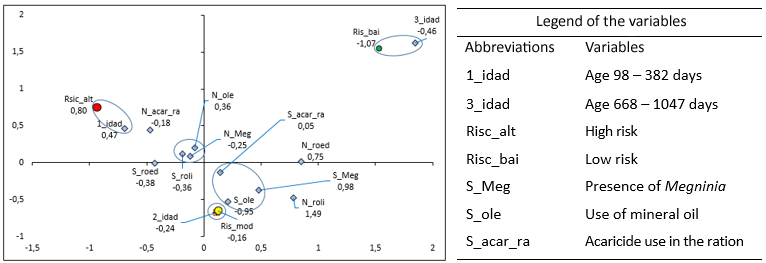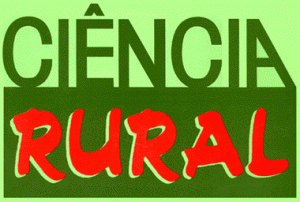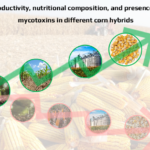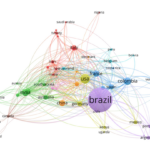By Tiago Mendonça, PhD. Student in Epidemiology at Veterinary School of UFMG, Belo Horizonte, MG, Brasil
Research titled “Epidemiological characterization and risk evaluation associated with the presence of Megninia spp. in posture farms”, published in the journal Ciência Rural, v. 47, n. 9, September 2017. The study is part of a partnership between researchers from the Federal University of Minas Gerais (UFMG), Fundação Ezequiel Dias, in Belo Horizonte, Federal University of Ouro Preto (UFOP), in Ouro Preto, and the Ministry of Agriculture, Livestock and Supply, in Minas Gerais, Brazil.
The researchers intended to evaluate and characterize the risks for the presence of Megninia spp. in sheds of posture farms of Minas Gerais. They used Correspondence Analysis (AC) in a secondary database, with information from 402 sheds of 42 commercial poultry farms. Crossing the variables considered as risk factors for the presence of these ectoparasites allowed the researchers to formulate a CA chart of epidemiological characterization of Megninia spp. (the analyzes are inside the blue circles).
 Graph of the correspondence analysis for the epidemiological characterization associated to the presence of Megninia spp. in chicken houses of poultry farms in the state of Minas Gerais, Brazil.
Graph of the correspondence analysis for the epidemiological characterization associated to the presence of Megninia spp. in chicken houses of poultry farms in the state of Minas Gerais, Brazil.
The researchers used as reference previous studies by Rezende, et al. (2013; 2015) and Tucci et al. (2005), among others, who investigated the epidemiology of Megninia spp. in Brazilian farms, also pointing out other factors that affect egg production.
Poultry farms with birds of many different ages and with younger chicken are predisposed to the presence of the ectoparasite, in addition to the presence of Megninia spp. to be associated with the use of mineral and acaricidal oil in the feed. On the other hand, the presence of rowing plants (Columbina talpacoti) appeared as a protection factor against Megninia spp.
Species of the Megninia type are responsible for significant losses in the poultry industry, affecting egg production. According to the researcher Tiago Mendonça, the importance of this study is to bring data that allow to implement more efficient measures of control and management that minimize the risk of the presence of the parasite in poultry farms. “As one of the risk factors is related to seedlings with birds of many different or younger ages, one of the measures would be to monitor these young birds and define moments of intervention in controlling the parasite,” says the researcher.
According to Tiago, there are few research groups studying birds ectoparasites in Brazil. Since 2009, his research group has been developing epidemiological studies on ectoparasites of laying birds. The researcher also points out some theses and dissertations on the subject developed in the Department of Preventive Veterinary Medicine of the UFMG Veterinary School.
References
REZENDE, L. C., et al. Mites affecting hen egg production: some considerations for Brazilian farms. Cienc. Rural [online]. 2013, vol. 43, no. 7, pp. 1230-1237, ISSN: 1678-4596 [viewed 03 October 2017]. DOI: 10.1590/S0103-84782013005000088. Avaliable from: http://ref.scielo.org/dphnxh
REZENDE, L. C., et al. Epidemiology of Megninia spp. in laying flocks from the State of Minas Gerais, Brazil. Rev. Bras. Parasitol. Vet. [online]. 2015, vol. 24, no. 2, pp. 198-203, ISSN: 1984-2961 [viewed 03 October 2017]. DOI: 10.1590/S1984-29612015027. Available from: http://ref.scielo.org/zmzm3s
TUCCI, E.C., et al. Infestação por Megninia spp. em criação industrial de aves produtoras de ovos para consumo. Arquivos do Instituto Biológico. 2005, vol. 72, no. 1, pp. 121-124.
To read the article, access it:
OLIVEIRA, T. M., et al. Epidemiological characterization and risk evaluation associated with the presence of Megninia spp. in posture farms. Cienc. Rural [online]. 2017, vol. 47, no. 9, e20170186, ISSN: 1678-4596 [viewed 03 October 2017]. DOI: 10.1590/0103-8478cr20170186. Avaliable from: http://ref.scielo.org/kxdnyj
External link
Ciência Rural – CR: <http://www.scielo.br/cr>
Como citar este post [ISO 690/2010]:

















Recent Comments